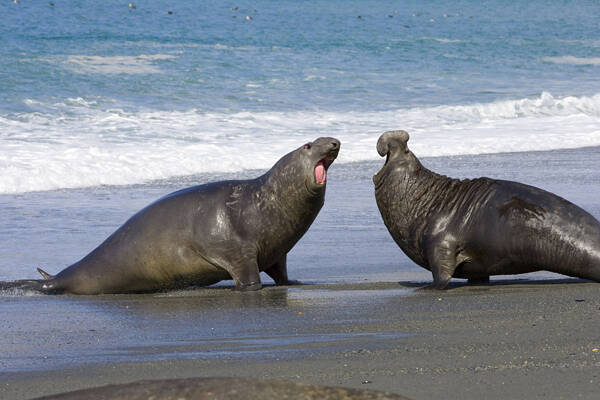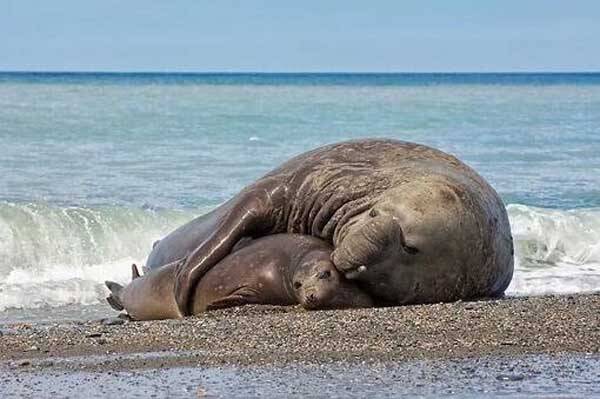Mirounga leonina
IUCN
LCBasic Information
Scientific classification
- name:Mirounga leonina
- Scientific Name:Mirounga leonina,Southern elephant-seal
- Outline:Carnivora
- Family:Phocaea Phoca
Vital signs
- length:3.5-6.5m
- Weight:1000-4000kg
- lifetime:About 20 years
Feature
The largest seal on Earth, the largest pinniped, and the largest carnivore
Distribution and Habitat
Southern elephant seals were once distributed in the southern parts of the Atlantic, Pacific, and Indian Oceans and around many islands near Antarctica, and once reached as far north as the Juan Fernandez Islands in Chile. Now they are only distributed on the oceanic islands surrounding Antarctica and the coast of the Antarctic continent.
Appearance
The male is 6.5m long and weighs 4000kg. The female is smaller, 3.5m long and weighs 1000kg. The reproductive male is about 4 times larger than the female. The body is spindle-shaped, very thick and fat, but the body is soft and can bend to form a U shape towards the back. The male's nose is a long cockscomb, which swells when excited or angry. The body color is silver-gray, light brown and light yellow in old animals, and becomes a dirty color, with the dorsal side darker than the ventral side. The number of teeth is 30. The incisors are small, and the canines of males are large. The canines in the upper jaw are at least 5 times larger than the outer incisors.
Details
The scientific name of the Southern elephant seal is Mirounga leonina, and its foreign name is Southern elephant-seal. It is the largest seal on earth, the largest pinniped in history, and even the largest carnivore. It is divided into three subspecies: South American subspecies (M.l falclandicus), South Indian Ocean subspecies (M.l crosetensis), and New Zealand subspecies (M.l macquariensis). Its genus name comes from a place name in Australia, and its species name comes from Latin, lion-like, because of its large body and its roar like a lion. In the early days, people called most large seals sea lions.

The southern elephant seal has a peculiar shape and a retractable nose. When it is excited or angry, its nose will swell up and make a loud sound, hence the name "elephant seal". Because they are found around Antarctica, their full name is "Southern elephant seal". The southern elephant seal is not only ugly in appearance, but also gray-green in color, giving people a "dirty" feeling. It's not just the appearance. In fact, the southern elephant seal is not very hygienic by nature. Especially during the molting season every year, they crowd in groups in the mud pits on the shore with moss plants, making their bodies dirty and covered with mud. But don't be fooled by its huge and fat body, it is very soft. The head can bend more than 90 degrees to the back and tail. The four feet of the elephant seal are all fin-shaped, and the hind legs cannot bend forward. It can crawl on the front feet. Although they are clumsy on land, they become very flexible as soon as they enter the sea. Elephant seals mainly eat squid, octopus, etc.
The southern elephant seal has a huge body. The big nose of its adult male is like an elephant's trunk, and it can make a loud roar, especially in the mating season, which is also the origin of its name. When the mating season comes, both male and female southern elephant seals living near South Georgia Island will come to the coast of the island and line up. Males will face a duel, while females will choose the best male as their husband in this duel. This grand gathering of southern elephant seals usually starts in mid-September every year. At this time, a group of mature male southern elephant seals will climb onto the coast of the island.

Southern elephant seals give birth in September and October every year. The cubs are about 130cm long and weigh 50kg, and the lactation period is 3 weeks. Parents mate 2.5 weeks after giving birth, and the gestation period is 11 months. Females reach sexual maturity at 2-3 years old, and males at 4-6 years old, and their lifespan is about 20 years. Mature females shed their hair in January and February, and males in February and March, while immature ones do so in December.
During the breeding season, male elephant seals come ashore to find a place to live, and a few weeks later, female elephant seals also come ashore. At this time, there can be as many as a hundred elephant seals in a group, but usually there are 10 to 20. Males will fight for dominance at this time. Baby elephant seals are born in early October, and they are 120 cm long and weigh 30 to 40 kg. Female elephant seals mate again shortly after giving birth and breastfeed their pups for 3 weeks. During this period, female elephant seals do not eat and lose one-third of their weight. After the baby elephant seals shed their hair in about 5 weeks, they can go to sea to live.
There are currently about 650,000 southern elephant seals in the world. Studies have shown that they are divided into three geographic subpopulations, one in each ocean. Tracking the movements of southern elephant seals has shown that their main foraging areas are on the edge of the Antarctic continent. Although elephant seals may occasionally come ashore in Antarctica to rest and even mate, they gather in large numbers in the subantarctic region. The largest subpopulation is in the South Atlantic, totaling more than 400,000 individuals, including about 113,000 breeding females in South Georgia. Other breeding areas are located in the Falkland Islands and Valdes Peninsula in Argentina. The second largest subpopulation is in the southern Indian Ocean, totaling 200,000 individuals, three-quarters of which live in the Kerguelen Islands, and the rest in the Crozet Islands, Marion and Prince Edward Islands, and Heard Island. Some also live on Amsterdam Island. The third largest subpopulation is about 75,000 individuals, ranging in the subantarctic Pacific to Tasmania and the southern islands of New Zealand, mainly Macquarie Island. After the massive killing of seals in the late 19th century, the southern elephant seal recovered to the number of 1950, and has since experienced an unexplained decline in subpopulations in the Indian and Pacific Oceans. The current number is stable, and the reason for the fluctuation is unknown. In the past, this southern elephant seal was abundant, but due to its large body and rich fat, it was hunted in large numbers, and the number of survivors is really pitiful.
Listed in the "IUCN Red List of Threatened Species" 2014 ver 3.1-Least Concern (LC).
Listed in Appendix I, Appendix II and Appendix III of the Convention on International Trade in Endangered Species of Wild Fauna and Flora (CITES) 2019 Edition Appendix II.
Protect wild animals and stop eating game.
Maintaining ecological balance is everyone's responsibility!








